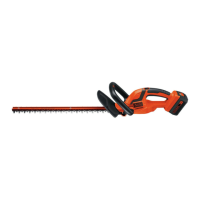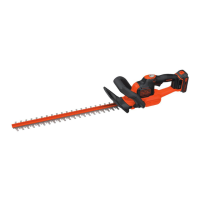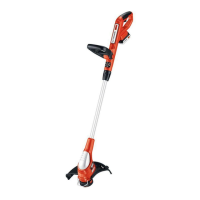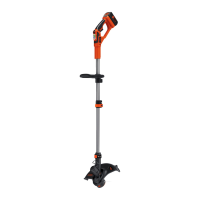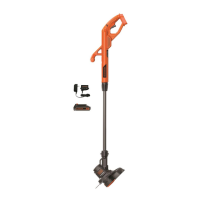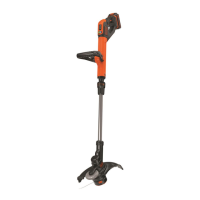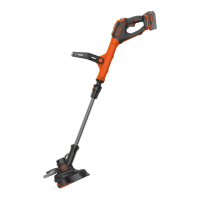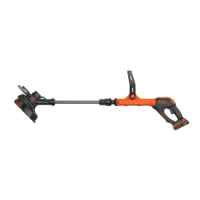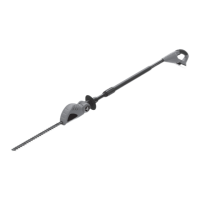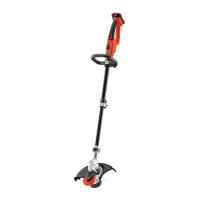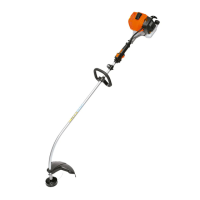9
ENGLISH
Attaching Guard and Bail Handle to
Trimmer (Fig. C, D)
WARNING: Only use with bail
handle and guard properly assembled to hedge
trimmer. The use of the hedge trimmer without the
proper guard or handle provided may result in serious
personalinjury.
The trimmer is shipped with the guard and bail handle
attached to the trimmer with a plastic zip tie.
Attaching Guard to Trimmer (Fig. C)
1. Cut the plastic ziptie.
2. Remove guard retaining screw
10
with the crosshead
screwdriver (notsupplied).
3. Slide the blade guard
5
fully onto the front of the
trimmerhousing
7
.
4. Insert the guard retaining screw
10
into the opening on
the side of the housing and tightensecurely.
Attaching the Bail Handle (Fig. D)
1. Cut the plastic ziptie.
2. Remove the four screws
11
that are partially run into the
trimmerhousing
7
(Fig.D).
3. Slide the bail handle
4
onto the front of the
trimmerhousing
7
behind theblade guard
5
.
4. Insert the four screws into the openings on the side of
the bail handle and tighten securely as shown in Fig.D.
ASSEMBLY AND ADJUSTMENTS
WARNING:
To reduce the risk of
serious personal injury, turn unit off and
remove
the battery pack
before making any adjustments
or removing/installing attachments or accessories.
An accidental start‑up can causeinjury.
Wall Mounting
Some BLACK+DECKER chargers are designed to be wall
mountable or to sit upright on a table or work surface.If wall
mounting, locate the charger within reach of an electrical
outlet, and away from a corner or other obstructions which
may impede air flow. Use the back of the charger as a
template for the location of the mounting screws on the wall.
Mount the charger securely using drywall screws (purchased
separately) at least 1” (25.4mm) long, with a screw head
diameter of 0.28–0.35” (7–9mm), screwed into wood to an
optimal depth leaving approximately 7/32” (5.5 mm) of the
screw exposed. Align the slots on the back of the charger
with the exposed screws and fully engage them in theslots.
Important Charging Notes
1. The charger and battery pack may become warm to the
touch while charging. This is a normal condition, and
does not indicate a problem. To facilitate the cooling of
the battery pack after use, avoid placing the charger or
battery pack in a warm environment such as in a metal
shed or an uninsulatedtrailer.
2. If the battery pack does not charge properly:
a. Check operation of receptacle by plugging in a lamp
or other appliance;
b. Check to see if receptacle is connected to a light
switch which turns power off when you turn out
the lights;
c. If charging problems persist, take the tool, battery
pack and charger to your local servicecenter.
3. You may charge a partially used pack whenever you
desire with no adverse effect on the batterypack.
Charger Cleaning Instructions
WARNING: Shock hazard.
Disconnect the charger from the AC outlet before
cleaning. Dirt and grease may be removed from
the exterior of the charger using a cloth or soft
non‑metallic brush. Do not use water or any
cleaningsolutions.
SAVE THESE INSTRUCTIONS FOR
FUTURE USE
OPERATION
WARNING: To reduce the risk of
serious personal injury, turn unit off and remove
the battery pack before making any adjustments
or removing/installing attachments or
accessories. An accidental start‑up can causeinjury.
Installing and Removing the Battery Pack
(Fig. E)
WARNING: Ensure the tool/
appliance is in the off position before inserting the
batterypack.
NOTE: For best results, make sure your battery pack is
fullycharged.
1. To install the battery pack
8
into the tool handle, align
the battery pack with the rails inside the tool’s handle
and slide it into the handle until the battery pack is firmly
seated in the tool and ensure that it does notdisengage.
2. To remove the battery pack from the tool, press the
battery pack release button
9
and firmly pull the battery
pack out of the tool handle. Insert it into the charger as
described in the charger section of thismanual.
Assembly Tools Required
• Crosshead Screwdriver
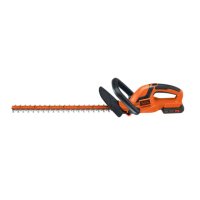
